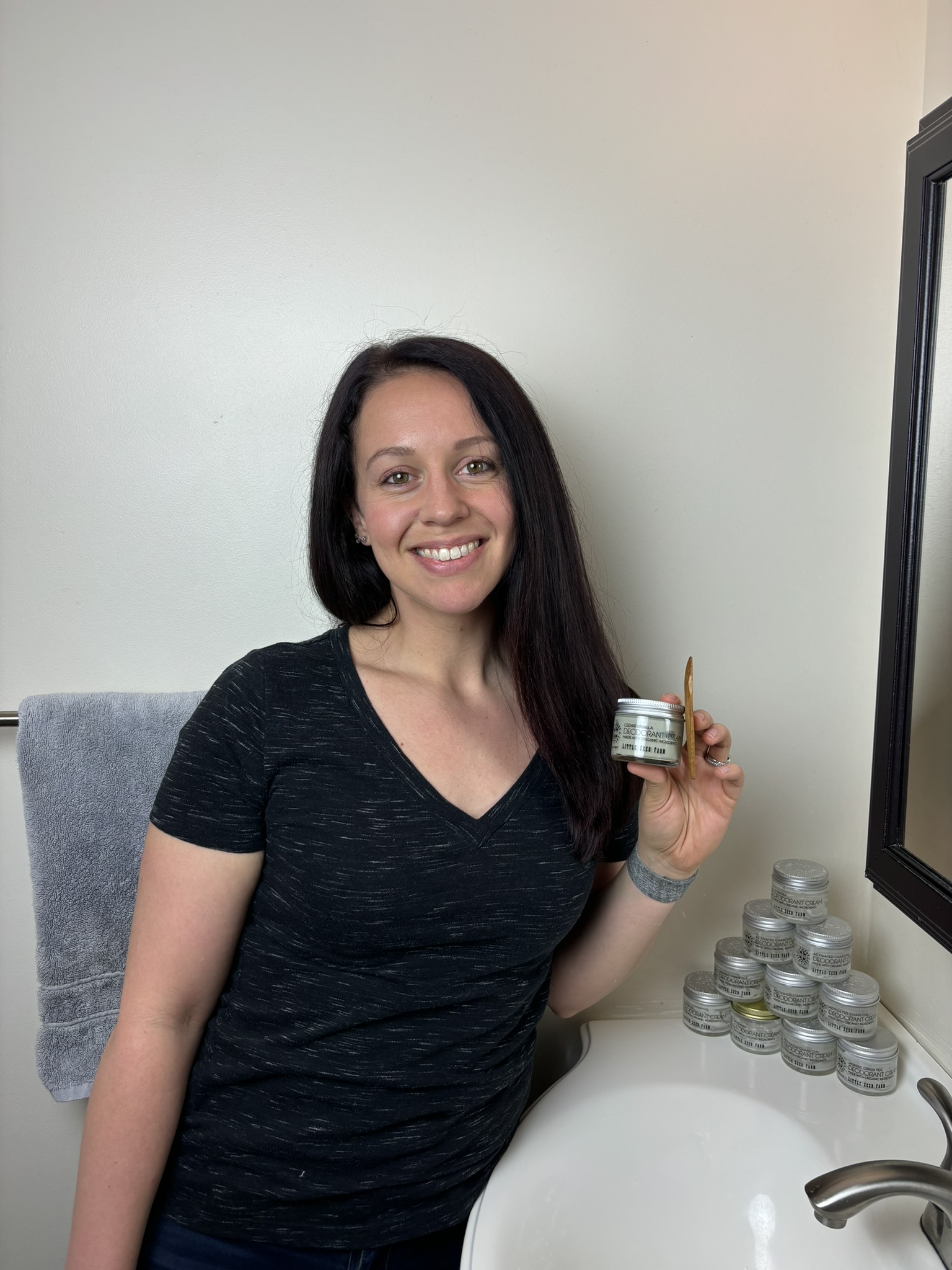The non-toxic trend
Deodorant is usually one of the first products that wellness professionals and influencers recommend switching when someone begins researching a “non-toxic” lifestyle. There’s a lot of stigma and feelings around “non-toxic” products from both sides. I want to take a quick sidebar to address those. I don’t necessarily agree with labeling items as non-toxic. Any material, even water, can be toxic depending on the quantity you use and how you use it. Maybe your deodorant isn’t toxic when you apply it to your armpits, but it could be toxic if your child ingests it. Labeling items as “non-toxic” seems to be more of a marketing ploy to a specific community.
However, I mostly agree with the sentiment behind “non-toxic” products. I do believe humans today are exposed to many environmental toxins. I also believe these toxins have a significant impact on our health and the environment. It’s difficult to quantify all of the toxins and what the actual threshold should be. Maybe it’s even different for each person! Subjectively speaking, I noticed positive changes in my health when I started to proactively lower the amount of environmental toxins I was being exposed to. Specifically I noticed easier periods, less mood swings, and better sleep. Certainly I’m still around environmental toxins everyday. In fact, sometimes I even knowingly choose an environmental toxin because I think it’s the best choice at that moment. I can’t live my life worrying about every single exposure. My goal is to make choices to lower environmental toxins based on evidence and logic, not fear.
Why deodorant matters
So why does deodorant matter so much in the wellness community as the “first” change you should make? To start, there are so many deodorant options out there. It’s simple to find a deodorant product you’re comfortable with. Deodorant is a product that people go through relatively quickly so it’s likely you’ll need to replace it soon. It’s also a fairly inexpensive switch to make. Lastly, it’s one of the more intimate personal care products people use on a daily basis. I hope I can provide you with enough information here to make the most educated decision for yourself and your family, depending on your needs.
Why we sweat (and why it smells)
The first thing that I want to establish is that sweating is an important bodily function. Sweating is how your body regulates its temperature. A basic principle of heat transfer is that if you have two objects with one at a higher temperature than the other and those two objects come into contact, heat will flow from the hotter object to the colder object. So when you workout, your contracting muscles produce heat in your body. Your body needs to get rid of the heat, so your brain tells your sweat glands to produce sweat. The sweat transfers the heat outside of your body in water droplets. The evaporation of sweat from your skin also produces a cooling effect. If you’re outside in the heat, the heat in the air (if it’s a higher temperature than your body) will transfer to your body and again your brain tells your sweat glands to produce sweat.
Our bodies have two types of sweat glands – eccrine and apocrine. Eccrine glands cover most areas of your body. Apocrine glands, however, are only present where you have hair follicles once you hit puberty, like your armpits for example. The sweat that comes out of our sweat glands includes water and salt (sodium chloride, primarily). Sweat on its own does not have a smell. However, when sweat interacts with bacteria on your body it can produce an odor. The apocrine glands are the primary source of “smelly sweat”.
Deodorant vs Antiperspirant
First we’ll cover some background information. When people refer to the term deodorant (at least where I live in the Midwest) they could mean antiperspirant or deodorant. The difference between these is an important distinction. An antiperspirant contains a material, typically an aluminum salt, that prevents you from sweating. It does this by “plugging” the glands that produce sweat. A deodorant, on the other hand, contains various materials that attempt to prevent or mask the smell your body produces when sweating. Antiperspirants can also contain various materials that mask the smell to perform as an antiperspirant and a deodorant all in one.
There are various things that weigh into someone’s decision to choose an antiperspirant or a deodorant. For some, the act of sweating is embarrassing. This is especially true if it’s in an environment that’s professional or during an important event. If you don’t have an antiperspirant you might sweat through your clothes and if you’re wearing an unforgiving color, everyone will know. For others, their body odor is much more concerning than how much they sweat. They need a deodorant to cover the odor because they feel embarrassed by it. And some people are concerned with both issues.
Breaking down the ingredients: aluminum
As with all personal care products there are a lot of ingredients in one stick of deodorant. Let’s break down the most common ingredients and why they may or may not be concerning. The most unique ingredient of potential concern in antiperspirant and deodorant is aluminum salts. Aluminum salts are the most common antiperspirant ingredient, which plugs your sweat glands and prevents them from producing sweat.
Breast cancer is commonly discussed as being linked to the aluminum salts in deodorant. Breast cancer is one of the main reasons there’s been a huge push for “natural” and “non-toxic” deodorant over the past few years. How could aluminum be a contributing cause for breast cancer? Aluminum is a metalloestrogen, which means it’s a metal that acts like estrogen in the body. Estrogen is a major contributor in breast cancer risk and growth according to the National Cancer Institute. However, the impact of metalloestrogens and other estrogen-mimicking ingredients (i.e. any materials that act like estrogen when they are in the body) on breast cancer risk and growth has not yet been scientifically proven. We’ll dig into estrogen-mimicking ingredients and why they matter in a bit.
Breaking down the ingredients: fragrance and preservatives
Other ingredients that are typically in antiperspirants and/or deodorants (along with other personal care products) are fragrances, spreading agents, skin moisturizers, and preservatives. There are many materials that can be labeled as “Fragrance” in an ingredient list. Fragrances can sometimes contain phthalates, even though it’s not called out specifically in the label. For this reason, you may not know whether or not potentially harmful ingredients are in a product you purchase. BHT and parabens are typically used as preservatives. Both phthalates and parabens mimic estrogen in the body as well. Again, the negative impact of estrogen-mimicking ingredients in the body has not yet been proven by scientific standards, which is why these materials are not restricted.
Why do estrogen-mimicking ingredients matter?
Looking at a few scientific studies, you’ll see conflicting evidence and conclusions. One study argues that studying individual ingredients to approve them for use may not be beneficial. It’s well known more than one personal care product is used per day in the same area. For example, you may apply a moisturizer, sunscreen, and deodorant all around your underarm on the same day. This mixture of ingredients is impossible to study. There are so many products and it’s usage-dependent. Thus an infinite number of combinations could exist on any day for any one person. Therefore, the study suggests that multiple estrogen-mimicking ingredients in personal care products could be a driving factor for breast cancer risk and growth. However, it’s a very difficult thing to prove given the almost infinite number of combinations an individual could experience.
Some common deodorant ingredients with known estrogen-mimicking effects are: aluminum, triclosan, parabens, and phthalates among others. Another study demonstrates a link between self-reported higher use of underarm cosmetic products to higher risk of developing breast cancer. The study also shows aluminum has been found in breast tissue in both patients with and without breast cancer. Statistically significant higher aluminum concentrations were found in those that had breast cancer. Self-reported data can be unreliable but the statistically significant conclusions found in this study should warrant further research.
The National Cancer Institute has reviewed data and studies by many scientists with conflicting hypotheses. After reviewing the studies the National Cancer Institute has stated there’s not enough evidence to scientifically prove a link between aluminum or parabens in antiperspirants and increased breast cancer risk. Due to this, they cannot recommend that people discontinue use of antiperspirants containing aluminum and parabens. With all of the conflicting information, it’s hard to figure out what choice is best. Since there’s conflicting evidence on the impact of aluminum and other estrogen-mimicking ingredients, I personally choose to avoid those ingredients. I would rather choose ingredients that aren’t in question instead of waiting years for scientists to statistically prove a link between an ingredient and cancer risk and realize I should’ve made a change years ago.
How to choose a safe and healthy deodorant
Deodorant without aluminum and parabens (i.e. what I’ve been referring to as a more natural deodorant) usually have two categories. Category one includes baking soda in the formulation and category two does not include baking soda. The top brand in category one is Primally Pure. I have never personally used Primally Pure deodorant, but I trust their ingredients. Their deodorant does contain baking soda, which can sometimes cause irritation for people with sensitive skin. However, the Primally Pure website claims they have formulated so little in the product that it should not irritate even extremely sensitive skin. Baking soda can also cause pigmentation of the skin, which may be a concern for some.
In my opinion, the best natural deodorant in category two without baking soda is Little Seed Farm. Little Seed Farm has many different scents and I have no concerns with any ingredients they use. One of the best parts is their recycling program! All you have to do is clean out your glass jars after the product is gone and send them back to the company where they will wash, sterilize, and repackage deodorant in the recycled glass jars. We usually buy deodorant once or twice a year in bulk to minimize the impacts of shipping. We also wait until we have quite a few glass jars to send back to them.
Do you have to “detox” when you make the switch to a more natural deodorant?
Many people say they sweat more with natural deodorant and when they switch to a more natural deodorant there’s a detoxification period from standard deodorant. The definition of detoxification is to remove harmful toxins from a living organism. There’s no evidence to show that’s what we’re doing when switching to a natural deodorant. If you are currently using an antiperspirant to purposefully plug your sweat glands and stop them from producing sweat, then it’s likely going to take your body some time to adjust to something new (in this case, sweating!).
Most people say it takes around two weeks for your body to adjust. I began using Little Seed Farm right around the COVID-19 pandemic. I had an abnormally long stretch of sitting at home where I could sweat and smell as much as I wanted as my body got used to my new deodorant. If you’re nervous about switching to a new deodorant, try to choose a time that would be less embarrassing if you get overly sweaty for a 2-3 week period.
How our diets affect our sweat
If you’re more worried about smelling bad when you switch to a more natural deodorant, there’s evidence that our diets have more to do with how our sweat smells than the amount we sweat. As mentioned earlier, the apocrine glands (anywhere on your body that sweats alongside hair follicles, like your armpits) produce the “smelly” sweat.
Foods that are high in sulfur contribute to sweat that smells bad. Some examples of foods that are high in sulfur are onions, garlic, cabbage, broccoli, cauliflower, and red meat. I eat most of these foods regularly and I think onions and garlic are the biggest triggers for me. However, it may be slightly different for everyone. Other food and drink items that can contribute to bad smelling sweat are alcohol, caffeine, certain spices like curry or cumin, and hot sauces or spicy foods. If you struggle with a strong odor, you can try eliminating or minimizing some of these items to see what impact it has on the smell of your sweat. I’ve been using Little Seed Farm for years now and I rarely have a strong odor, most of which I contribute to the foods I eat.
Have you made the switch?
If you’ve already made the switch to a more natural deodorant rather than an antiperspirant, feel free to share how your switch was similar or different from my experience. I’d love to hear what deodorant brands you’ve found that work best! If you’re new to this space, I hope the information found here was helpful as you consider switching to a more natural deodorant.
SOURCES:
- https://www.ncbi.nlm.nih.gov/pmc/articles/PMC4017651
- https://www.cancer.gov/about-cancer/causes-prevention/risk/myths/antiperspirants-fact-sheet#q3s
- https://www.ncbi.nlm.nih.gov/pmc/articles/PMC6773238
- https://www.ncbi.nlm.nih.gov/pmc/articles/PMC8998800
- https://my.clevelandclinic.org/health/symptoms/17865-body-odor
- https://www.ncbi.nlm.nih.gov/pmc/articles/PMC2797685
- https://www.ncbi.nlm.nih.gov/pmc/articles/PMC5514401
- https://www.mamavation.com/beauty/toxic-deodorants.html#Not_Our_Favorite_Deodorants









